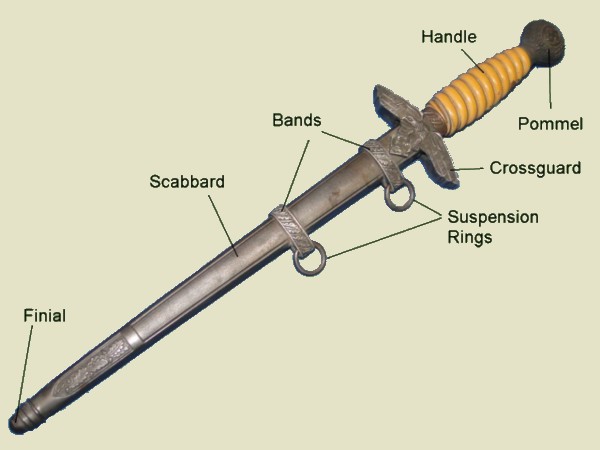THE HISTORY OF THE 2ND MODEL LUFTWAFFE DAGGER

Luftwaffe is a generic German term for an air force. It is also the official name for the German air force
during WWII. Founded in 1933 and disbanded in 1946.
On February 26, 1935, Adolf Hitler ordered Hermann G�ring to establish the Luftwaffe, breaking the Treaty of
Versailles's ban on German military aviation. Germany violated the treaty without sanction from Britain and
France or the League of Nations, and neither they nor the league did anything to oppose this. Although the new
air force was to be run totally separately from the army, it retained the tradition of according army ranks for
its officers and airmen, a tradition retained today by united Germany's Luftwaffe and by many air forces
throughout the world. It is worth noting, however, that before the official promulgation of G�ring's new
Luftwaffe in 1935, Germany had a paramilitary air force known as the Deutscher Luftsportverband (DLV: German air
sports union). The DLV was headed by Ernst Udet and its insignia were taken over by the new Luftwaffe,
although the DLV "ranks" had special names that made them sound more civilian than military.

THE ORIGIN OF THE 2nd MODEL LUFTWAFFE DAGGER
 |
The Luftwaffe had two daggers. The first model and the second model.
The second pattern Luftwaffe dagger was introduced in 1937. Various officer ranks wore the dagger and there was
no visible difference between them.
The biggest changes between the first model and the second model were the pommel and the hand guard. A detailed
account of the construction of the dagger follows:
The blade was of type stiletto with the main features being a double edge and a flat plain in its center. The
brand of the manufacturer would normally be placed on the blade. The example shown in this page has a
manufacturer's marking from F.W. Holler. The grip was constructed from celluloid and consisted of a grooved
spiral design. A wire composed of three strands was placed in the groove. The wire was aluminum and silver
in appearance. The grip was available in white, yellow or orange. If the buyer had the necessary finances,
it was possible to purchase ivory grips. The various types of grips available were strictly a matter of purchaser
preference and not a symbol of rank or status within the Luftwaffe.
|
PRODUCTION NUMBERS
|
The 2nd Model Luftwaffe dagger was produced by a very large number of manufacturers. The logo of the maker was
nornally stamped near the base of the blade. However, in some cases the blade is unmarked. This is correct
for the period.
|
 |
RZM CONTROL NUMBERS
 |
As the number of organizations grew, so did the number of types of daggers. Pretty soon it was clear that
this was a logistical nightmare. There were so many companies producing daggers and dagger parts but there
was no standards for them to follow. As long as the items looked correct they were produced and sold. The
problem is that parts among manufacturers were not interchangeable.
The solution to this problem was to implement construction standards. Sizes, colors, materials, etc. All of
it needed to be controlled. The standard that was created was known as RZM.
This explains why today it is difficult to assamble a dagger from parts. For example, if you have a dagger
that is missing the handle. you find one for sale. the color and materials look good. You purchase it
and take it home just to find out it does not fit or that it fits poorly.
|
DAGGER REPRODUCTIONS
Like many other German WWII items, Reproductions of the 2nd Model luftwaffe dagger have been produced. The
quality of the reproductions extend from very good to bad. Spain produced some decent quality reproductions
during the late 1950's and the 1960's.
POST-WAR PRODUCTION
At the end of the war most German cities were virtually destroyed. Daily life activities that were once taken for
granted became difficult things to achieve. Chief among the worries was how to make a living.
As the ranks of the GI's swelled with fresh troops arriving from the States to perform the duties of an
occupation force, a new industry was being created, selling souvenirs to soldiers who had money to spend.
Factories who had left over stock of blades and parts saw a golden opportunity. They started assembling daggers
to sell to the GI's. It is generally believed that this practice took place primarily between the years of 1946
and 1948. By 1951 the use of the swastika was banned in Germany. Therefore eliminating production of daggers.
one common denominator among post-war daggers is that the word "Germany" was stamped at the base of the blade.
As the original parts ran out new ones would be manufactured from the original molds. Post-war daggers are
quickly becoming a collectible field of its own.
| WWII GERMAN SECOND MODEL LUFTWAFFE DAGGER EXAMPLES |
The more examples of a particular dagger that are examined the more knowledge is gained about the particular piece. Differences in construction can be better appreciated. Markings on the blade and other sections are better understood. The overall knowledge about the dagger is expanded.
This section of the site provides several examples of the dagger.
INTERESTED IN BUYING OR SELLING A LUFTWAFFE DAGGER?
Visit the
"German WWII -> Daggers and Parts"
section of our store to see the available inventory. All items there have a money-back guarantee to be original,
unless otherwise stated. You can buy from us with confidence.
Fell free to contact us. We will make you an offer for a single item or an entire collection.
Page 1
Continued - The history of the 2nd Model Luftwaffe dagger

While the item featured here is not for sale, similar items like it are available for
purchase in our website MilitaryItems.com
|





